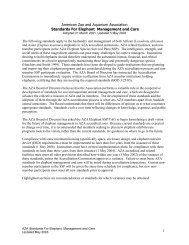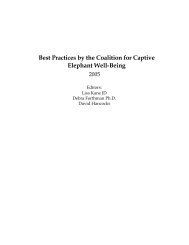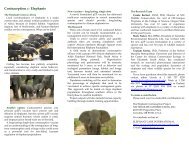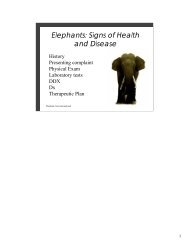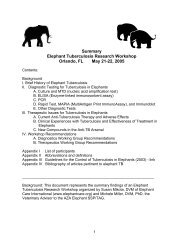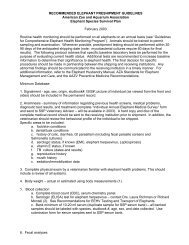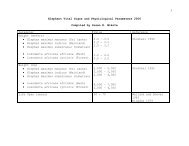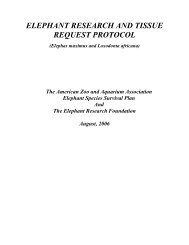Nepal Elephant TB Control and Mgt Action Plan.pdf - Elephant Care ...
Nepal Elephant TB Control and Mgt Action Plan.pdf - Elephant Care ...
Nepal Elephant TB Control and Mgt Action Plan.pdf - Elephant Care ...
- No tags were found...
Create successful ePaper yourself
Turn your PDF publications into a flip-book with our unique Google optimized e-Paper software.
<strong>Nepal</strong> <strong>Elephant</strong> Tuberculosis <strong>Control</strong> <strong>and</strong>Management <strong>Action</strong> <strong>Plan</strong> (2011-2015)Appendix III<strong>Nepal</strong> <strong>Elephant</strong> Postmortem ProtocolSpecial considera!ons for <strong>TB</strong>-infected elephants or <strong>TB</strong> suspectsA thorough search for lesions of tuberculosis (<strong>TB</strong>) is encouraged in all elephant necropsies especiallyelephants that are known to be reacve on the <strong>Elephant</strong> <strong>TB</strong> Stat-Pak ® <strong>and</strong> DPP Vet ® <strong>TB</strong> tests. <strong>Elephant</strong><strong>TB</strong> is likely to be caused by M. tuberculosis or M. bovis which are contagious to humans. Wear properprotecve apparel, <strong>and</strong> contain any suspicious organs or lesions as soon as possible. All involved personnelshould wear N-95 masks.Approach: During examinaon of an elephant with unknown, suspicious, or posive <strong>TB</strong> test history, disseconof the thoracic cavity should always be performed last, <strong>and</strong> should be done by two people withN-95 face masks <strong>and</strong> other protecve clothing. All other personnel should be dismissed from the areabefore the thoracic cavity is entered. A!er the abdominal viscera have been removed, the diaphragmcan be cut from its costo-sternal a"achments <strong>and</strong> the lungs palpated from a caudal approach for tuberculosisnodules, as the lobes are being separated from the closely adhered visceral <strong>and</strong> parietal pleura.The heart, lungs, <strong>and</strong> associated structures may then be removed “en bloc”.Necropsy procedures: <strong>Care</strong>fully examine the tonsillar regions <strong>and</strong> sub-m<strong>and</strong>ibular lymph nodes for <strong>TB</strong>lesions. These lymph nodes may be more easily visualized following removal of the tongue <strong>and</strong> laryngealstructures during the dissecon. All lymph nodes should be carefully evaluated for lesions sinceother sites may also be infected (ex. reproducve or gastrointesnal tract). Take any nodes that appearcaseous or granulomatous for culture (freeze or place in sodium borate) <strong>and</strong> histopathology (in buffered10% formalin).Search thoracic organs carefully for early stages of <strong>TB</strong> as follows: a!er removal of the lungs <strong>and</strong> trachea,locate the bronchial nodes at the juncon of the bronchi from the trachea. Secon the nodes <strong>and</strong> collectin formalin even if no lesions are present. If lesions are present, place half of the lymph node in a 50 mlscrew-top tube <strong>and</strong> submit for culture.<strong>Care</strong>fully, palpate the lobes of both lungs from the apices to the caudal borders to detect any firm B-Bshot to nodular size lesions. Take numerous (5 or more) secons of any suspicious lesions. Open the trachea<strong>and</strong> look for nodules or plaques <strong>and</strong> process as above. Regional thoracic <strong>and</strong> tracheal lymph nodesshould also be examined <strong>and</strong> processed accordingly. Split the trunk from the p to its inseron <strong>and</strong> takesamples of any plaques, nodules or suspicious areas for <strong>TB</strong> diagnosis as above. Look for <strong>and</strong> collect possibleextra-thoracic <strong>TB</strong> lesions, parcularly if there is evidence of advanced pulmonary <strong>TB</strong>.35




